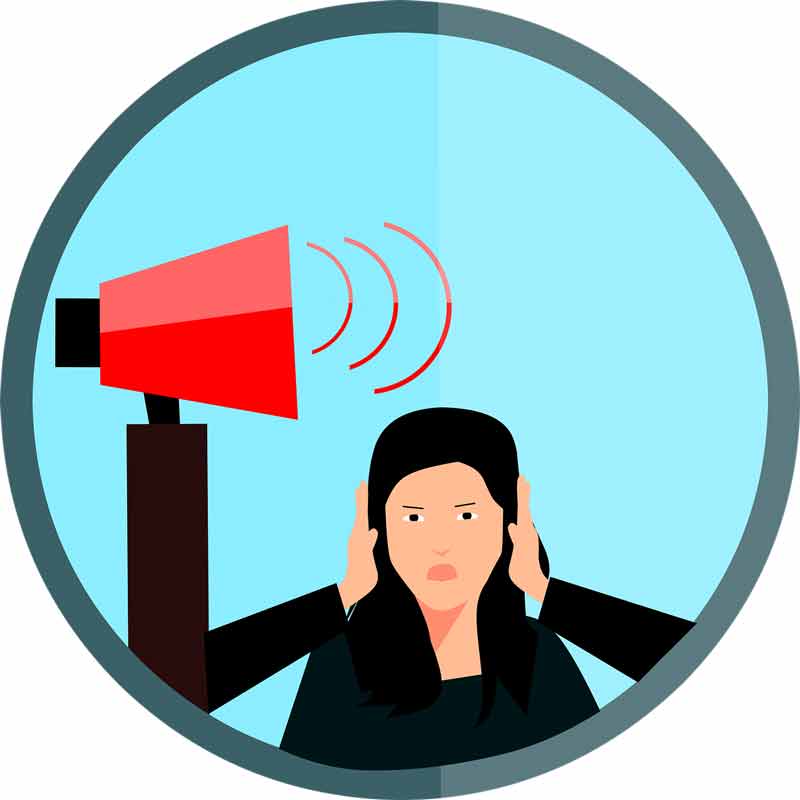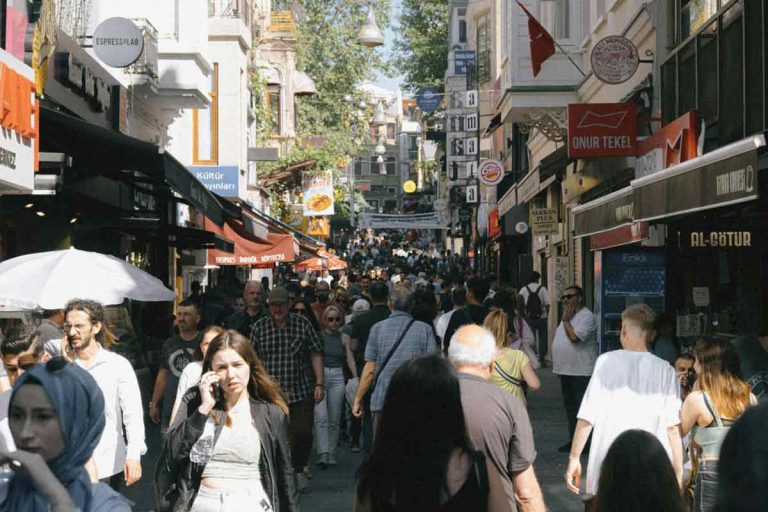Paragraph On Noise Pollution – Unique and Edifying
As we navigate our daily lives amidst this auditory assault, it’s easy to become desensitized to the constant barrage of sound. Yet, beneath the surface lies a silent threat that permeates every aspect of our existence.
Studies have shown that prolonged exposure to high levels of noise can lead to stress, insomnia, hearing loss, and even cardiovascular problems. Furthermore, wildlife populations are also at risk as their habitats shrink in the face of encroaching human noise.
Noise pollution is not just an annoyance; it is a serious public health concern that demands our attention and action.
So let’s read this paragraph on noise pollution to know more distant.
| Sound Source | Decibel Level (dB) | Effects |
|---|---|---|
| Whisper | 30 | Barely audible, with minimal disturbance. |
| Normal Conversation | 60 | Typical conversation level, moderate disturbance. |
| Motorcycle Engine Running | 95 | Loud, potentially harmful over prolonged exposure. |
| Noise above 70 dB | 70+ | Prolonged exposure may damage hearing. |
| Loud Noise above 120 dB | 120+ | Immediate harm to ears, potential for permanent damage. |
Short Paragraph On Noise Pollution 100 Words
Noise pollution, stemming from uncountable sources including railway operations, construction sites, industrial activities, aircraft traffic, community events, and transportation systems, poses a significant threat to human well-being. The relentless barrage of noise from these sources can lead to hearing impairments, sleep disturbances, heightened stress levels, and impaired cognitive function among affected individuals. Moreover, chronic exposure to elevated noise levels has been linked to cardiovascular issues and mental health disorders. Mitigating the adverse effects of noise pollution requires concerted efforts in urban planning, technological innovation, and regulatory measures to safeguard public health and enhance the quality of life in noisy environments.
Paragraph On Noise Pollution 150 Words
Noise pollution is a pervasive environmental issue resulting from excessive and unwanted sound that disrupts the natural balance of an ecosystem.
Sources of noise pollution are diverse, ranging from industrial activities, transportation systems, construction sites, and urban areas to recreational activities like loud music events and sports events.
The effects of noise pollution extend far beyond mere annoyance, impacting human health, wildlife, and the environment. Chronic exposure to high levels of noise can lead to hearing loss, cardiovascular problems, sleep disturbances, and heightened stress levels among humans. Wildlife species, particularly those relying on acoustic communication for survival, face disruptions in breeding patterns, foraging behaviors, and territorial defense due to noise pollution.
Moreover, noise pollution can degrade natural habitats, alter ecosystems, and interfere with the migration patterns of various animals. To mitigate the adverse effects of noise pollution, comprehensive strategies such as implementing noise regulations, utilizing soundproofing technologies, promoting public awareness, and incorporating urban planning designs that prioritize noise reduction are imperative.
Addressing noise pollution not only enhances the quality of life for humans but also preserves the delicate balance of ecosystems for future generations.
Noise Pollution Paragraph 200 Words
As the city awakens to the dawn chorus of traffic and industry, noise pollution emerges as the unwanted conductor, orchestrating a discordant symphony that drowns out the natural harmonies of the environment, leaving only chaos in its wake. The rhythmic pounding of construction, the blaring horns of impatient drivers, and the constant hum of machinery blend together to form a dissonant melody that pervades every corner of urban life.
The effects of noise pollution are manifold and can have serious consequences on both human health and the ecosystem. Prolonged exposure to high levels of noise can lead to hearing loss, sleep disturbances, stress, hypertension, and impaired cognitive function. It can also disrupt communication and social interaction, affecting productivity and overall quality of life.
Furthermore, noise pollution negatively impacts wildlife, disrupting their natural behaviors, communication patterns, and breeding habits. Marine life, in particular, is vulnerable to noise pollution from activities such as shipping, underwater construction, and naval sonar, leading to disorientation, habitat displacement, and even death.
Addressing noise pollution requires a multi-faceted approach, including soundproofing measures, urban planning strategies, and the enforcement of noise regulations. Public awareness campaigns and community involvement are also crucial in fostering a culture of noise reduction and responsible noise management. By mitigating noise pollution, we can protect both human well-being and the delicate balance of the natural world.
Paragraph on Sound Pollution 150 Words

Sound pollution is a pervasive environmental issue caused by excessive and unwanted sound that disrupts the natural balance of the environment.
From the bustling streets of urban centers to the industrial hum of factories, sound pollution pervades both rural and urban areas alike. It stems from various sources such as transportation, construction activities, industrial machinery, and recreational events. Prolonged exposure to high levels of noise can lead to a myriad of health problems including hearing loss, stress, sleep disturbances, and even cardiovascular issues.
Furthermore, wildlife is also adversely affected, with disruptions to their natural habitats and communication patterns. Mitigating sound pollution requires collective efforts, including stricter regulations on noise levels, soundproofing measures in buildings, and promoting public awareness about the importance of maintaining acoustic environments conducive to well-being.
By addressing sound pollution, we can create healthier and more harmonious living spaces for both humans and the natural world.
Paragraph on Noise Pollution 250 Words
In the bustling tapestry of urban life, amidst the honking of cars, the clamor of construction sites, and the incessant hum of machinery, there exists an often overlooked but pervasive menace: noise pollution. Defined as unwanted or harmful sound that disrupts the environment, noise pollution has become an undeniable feature of modern society.
The consequences of noise pollution extend far beyond mere annoyance. Scientific research has linked prolonged exposure to excessive noise levels with a myriad of health issues, including hearing loss, sleep disturbances, elevated stress levels, and even cardiovascular problems. Moreover, noise pollution doesn’t discriminate—it affects individuals of all ages and socioeconomic backgrounds, infiltrating homes, schools, workplaces, and recreational spaces alike.
But noise pollution isn’t solely a health concern; it also encroaches upon our ecological balance. Animals, particularly those in urban environments, suffer from disrupted communication patterns, altered migration routes, and heightened stress levels due to anthropogenic noise. Marine life, in particular, faces dire consequences from underwater noise pollution, impacting everything from navigation to mating behaviors.
Addressing noise pollution requires a multi-faceted approach, encompassing stricter regulations, innovative urban planning strategies, and increased public awareness. By prioritizing quieter transportation modes, implementing soundproofing measures, and fostering a culture of respect for quiet spaces, we can mitigate the detrimental effects of noise pollution and create healthier, more harmonious environments for all. It’s time to tune into the silent plea of our surroundings and take decisive action against the deafening reality of noise pollution.
Long Paragraph On Noise Pollution 500 Words
Noise pollution is a serious issue that affects all of us, whether we realize it or not. Imagine a world where every sound, from the chirping of birds to the laughter of children, is drowned out by the constant roar of traffic, the buzz of machinery, and the blare of loud music. That’s the world we could be headed towards if we don’t take action against noise pollution. But what exactly is noise pollution, you may wonder? Well, let’s break it down. Noise pollution occurs when there is an excessive amount of unwanted or disturbing noise in the environment, which can be harmful to both our physical and mental health.
Now, where does all this noise come from? There are many sources of noise pollution, and some of them might surprise you. One of the most common sources is transportation, particularly traffic noise from cars, trucks, buses, and motorcycles. Just think about how noisy it can get when you’re stuck in a traffic jam or waiting at a busy intersection. But it’s not just traffic that’s to blame. Airplanes flying overhead can also contribute to noise pollution, especially if you live near an airport. Then there are the sounds of construction sites, with their jackhammers, drills, and heavy machinery creating a cacophony of noise that can be heard for blocks around. And let’s not forget about all the noise we make ourselves, whether it’s playing loud music, shouting, or even just slamming doors and banging on pots and pans.
So, with all this noise around us, what can we do to prevent noise pollution and create a quieter, more peaceful environment? Well, there are several steps we can take, both individually and collectively. One of the most important things we can do is to be mindful of the noise we make ourselves. That means keeping the volume down on our music and TVs, using headphones instead of blasting our music from speakers, and being considerate of our neighbors, especially late at night or early in the morning. We can also try to choose quieter modes of transportation, like walking or biking instead of driving, and advocate for better public transportation options in our communities.
But preventing noise pollution isn’t just about changing our own behavior; it’s also about advocating for change on a larger scale. That means supporting policies and regulations that limit noise emissions from vehicles, machinery, and other sources. It means encouraging the development of quieter technologies and soundproofing measures in our buildings and infrastructure. It means raising awareness about the harmful effects of noise pollution and the importance of protecting our environment from its effects.
Another way we can help prevent noise pollution is by planting trees and other greenery in our communities. Not only do trees provide shade and beauty, but they also act as natural sound barriers, absorbing and blocking out some of the noise from nearby roads and buildings. By planting trees in our neighborhoods, parks, and schoolyards, we can create more peaceful and pleasant environments for ourselves and future generations to enjoy.
Finally, it’s important to remember that preventing noise pollution isn’t just about creating a quieter environment; it’s also about protecting our health and well-being. Excessive noise can have a range of negative effects on our physical and mental health, from hearing loss and sleep disturbances to stress, anxiety, and even cardiovascular problems. By taking action to reduce noise pollution in our communities, we can help improve not only our quality of life but also our overall health and happiness.
Lastly, noise pollution is a serious issue that affects us all, but it’s not one that we have to accept as inevitable. By taking simple steps to reduce the noise we make ourselves, advocating for change on a larger scale, and creating more peaceful and green environments in our communities, we can all play a part in preventing noise pollution and creating a quieter, healthier world for ourselves and future generations. So let’s raise our voices against noise pollution and work together to turn down the volume of noise in our lives.
Noise Pollution Effects
Noise pollution, an often underestimated environmental concern, has pervasive effects on various aspects of life, ranging from human health to ecosystem stability. Understanding these effects is crucial for implementing effective mitigation strategies and fostering a healthier environment for all living beings.
Noise Pollution Effects on Human
Noise pollution, characterized by unwanted or harmful sound that disrupts normal activities, has significant effects on human health across various dimensions. Prolonged exposure to high levels of noise can lead to a range of physical, psychological, and cognitive ailments.
- Hearing Loss: One of the most direct consequences of noise pollution is hearing impairment. Exposure to loud noises, especially over an extended period, can damage the delicate structures of the inner ear, leading to temporary or permanent hearing loss. This effect is particularly pronounced in occupational settings such as construction sites, factories, and airports, where workers are exposed to high levels of noise without adequate protection.
- Sleep Disturbances: Noise pollution disrupts sleep patterns, leading to insomnia and other sleep-related disorders. Even low-level background noise can interfere with the ability to fall asleep or stay asleep, reducing overall sleep quality and leaving individuals feeling fatigued and unrefreshed. This is especially problematic in urban areas where ambient noise from traffic, industry, and nightlife is prevalent.
- Cardiovascular Issues: Chronic exposure to noise pollution is associated with an increased risk of cardiovascular diseases such as hypertension, heart disease, and stroke. The stress response triggered by loud or incessant noise leads to the release of stress hormones like cortisol and adrenaline, which can elevate blood pressure and contribute to the development of cardiovascular conditions over time.
- Mental Health Disorders: Noise pollution has been linked to various mental health issues, including anxiety, depression, and irritability. Living in noisy environments can exacerbate stress levels and negatively impact emotional well-being, particularly among vulnerable populations such as children, the elderly, and individuals with pre-existing mental health conditions.
- Impaired Cognitive Function: Exposure to noise pollution can impair cognitive function, affecting memory, concentration, and problem-solving abilities. Studies have shown that chronic noise exposure, especially during critical periods of development, can hinder cognitive development in children and impair academic performance.
- Social Isolation: In addition to its direct physiological effects, noise pollution can contribute to social isolation and decreased quality of life. High levels of noise can disrupt communication and interpersonal interactions, leading to feelings of alienation and disconnection within communities.
Noise Pollution Effects on the Environment
Noise pollution disrupts the natural acoustic environment, affecting both terrestrial and aquatic ecosystems. In terrestrial environments, excessive noise can alter animal behavior, disrupt communication patterns, and interfere with mating rituals, ultimately leading to reduced reproductive success and population decline. In aquatic ecosystems, noise pollution from sources such as shipping, construction, and recreational activities can disturb marine life, including marine mammals, fish, and invertebrates, impacting their feeding, migration, and breeding behaviors.
Noise Pollution Effects on Ecosystems
The impacts of noise pollution ripple through ecosystems, affecting not only individual species but also the overall ecological balance. Changes in animal behavior due to noise disturbance can cascade through food webs, leading to shifts in species composition and ecosystem dynamics. In sensitive ecosystems such as wetlands and forests, noise pollution can disrupt critical processes like seed dispersal and pollination, threatening the integrity of these habitats.
Noise Pollution Effects on Animals and Wildlife
Wildlife species are particularly vulnerable to the effects of noise pollution, as many rely on acoustic signals for communication, navigation, and survival. Noise from anthropogenic sources can mask these signals, making it difficult for animals to detect predators, find mates, and locate resources. In addition to direct physiological effects, chronic noise exposure can induce chronic stress in wildlife populations, compromising their resilience and fitness over time.
Noise Pollution Effects on Plants
While often overlooked, noise pollution can also impact plant physiology and ecosystem dynamics. Studies have shown that noise exposure can alter plant growth patterns, leaf morphology, and reproductive success. In forested areas, noise pollution can disrupt mutualistic interactions between plants and pollinators, leading to decreased seed production and genetic diversity.
Noise Pollution Effects on Health
Beyond the immediate physiological impacts, noise pollution can have far-reaching consequences for public health. Chronic noise exposure has been associated with an increased risk of hypertension, cardiovascular disease, and adverse birth outcomes. Moreover, noise pollution can exacerbate existing health disparities, disproportionately affecting communities located near noisy infrastructure or industrial sites.
In conclusion, noise pollution poses multifaceted threats to human health, environmental quality, and ecosystem stability. Addressing this issue requires a comprehensive approach that integrates sound management practices, policy interventions, and public awareness initiatives to mitigate the adverse effects of noise pollution on both present and future generations.
What is Noise?
In general terms, noise refers to any unwanted or undesirable sound, interference, or disturbance that disrupts the desired signal or environment. It can manifest in various forms, including:
- Acoustic Noise: This is the most common form of noise, referring to unwanted sound that can be heard by the human ear. It can come from sources such as traffic, machinery, construction, or loud neighbors.
- Electrical Noise: In electrical systems, noise refers to unwanted electrical signals that interfere with the desired signal. This can be caused by factors like electromagnetic interference (EMI), radio frequency interference (RFI), or poor electrical connections.
- Visual Noise: This refers to unwanted visual distractions or disturbances, such as cluttered or chaotic imagery, which can interfere with perception or understanding.
- Data Noise: In digital systems or communication channels, noise can refer to errors or discrepancies in transmitted data that result from interference, distortion, or corruption during transmission.
Noise can have various effects depending on the context. In communication systems, it can degrade signal quality and reduce the reliability of transmitted information. In environments such as workplaces or homes, excessive noise can cause stress, fatigue, and even health issues over time. Therefore, noise control measures are often implemented to mitigate its effects and maintain a desirable level of comfort and functionality.
Types of Noise
| Type of Noise | Description |
|---|---|
| Continuous Noise | Consistent and steady noise, such as the hum of machinery or constant traffic noise. |
| Intermittent Noise | Occasional bursts of noise with periods of quiet in between, like construction work or passing vehicles. |
| Impulsive Noise | Sudden, sharp sounds with high intensity and short duration, such as fireworks or gunshots. |
| Low-Frequency Noise | Low-pitched noise often associated with industrial operations or large machinery. |
| White Noise | Random noise with equal energy across all frequencies, often used for masking other sounds. |
| Pink Noise | Noise with equal energy per octave, often perceived as more balanced and natural than white noise. |
What is Noise Pollution?
Noise pollution refers to the excessive, unwanted, or harmful levels of noise in the environment that disrupt the natural balance and interfere with normal activities. It is often caused by human activities and can have detrimental effects on human health, wildlife, and the overall quality of life.
| What Causes Noise Pollution? | Description |
|---|---|
| Noise Regulations | Lack or inadequate enforcement of noise regulations |
| Construction noise | Noise generated from construction activities |
| Transportation | Various modes of transportation contribute to noise pollution |
| Air traffic noise | Noise generated by aircraft during takeoff, landing, or in-flight |
| Construction | General construction activities contributing to noise pollution |
| Fireworks | Noise generated from fireworks displays |
| Social events | Loud gatherings or events causing noise disturbance |
| Animals | Natural or domesticated animals contributing to noise pollution |
| Industrial causes | Noise generated from industrial operations |
| Nightlife | Noise from entertainment venues or nightlife activities |
| Noise from railroads | Trains and railroad operations causing noise pollution |
| Urban planning | Poorly designed urban areas contributing to noise pollution |
So How to Prevent Noise Pollution?
Preventing noise pollution requires a combination of individual actions, community efforts, and governmental regulations. Here’s a comprehensive guide to help mitigate noise pollution:

- Understand Noise Pollution: Educate yourself and others about noise pollution, its sources, and its effects on health and well-being.
- Use Quieter Equipment: Choose appliances, vehicles, and machinery that produce less noise. Look for products with low noise ratings when making purchasing decisions.
- Maintain Equipment Regularly: Regular maintenance can help reduce noise from machinery and vehicles by ensuring they operate smoothly.
- Insulate Buildings: Improve insulation in homes, offices, and public buildings to reduce the transmission of noise from outside.
- Plant Vegetation: Plant trees, shrubs, and bushes to create natural barriers that absorb sound and reduce noise levels.
- Use Noise Barriers: Install barriers such as walls, fences, or soundproof windows to block or reduce noise from nearby roads, railways, or industrial areas.
- Control Construction Noise: Implement measures to minimize noise during construction activities, such as using quieter equipment, scheduling noisy tasks during less sensitive hours, and providing sound barriers.
- Regulate Traffic: Encourage the use of public transportation, carpooling, and alternative transportation methods to reduce traffic congestion and associated noise.
- Implement Noise Ordinances: Advocate for the enforcement of noise ordinances at the local, state, and national levels. These regulations can restrict noise levels in residential, commercial, and industrial areas during specific hours.
- Promote Soundproofing: Encourage homeowners and businesses to invest in soundproofing measures such as double-glazed windows, acoustic ceiling tiles, and door seals.
- Raise Awareness: Organize community events, workshops, and campaigns to raise awareness about noise pollution and its impacts. Encourage individuals and businesses to take responsibility for reducing noise levels.
- Use Noise-Canceling Technology: Utilize noise-canceling headphones or earplugs in noisy environments to protect hearing and minimize exposure to excessive noise.
- Support Research: Advocate for funding and support for research into noise pollution and its effects on human health, wildlife, and ecosystems. Use scientific findings to inform policy decisions and public awareness campaigns.
- Encourage Responsible Behavior: Encourage individuals to be mindful of their noise levels, especially in residential areas. Avoid unnecessary honking, loud music, and other sources of noise disturbance.
- Participate in Community Planning: Get involved in urban planning processes to advocate for quieter and more sustainable development practices. Consider noise pollution when designing new infrastructure and residential areas.
Thanks for reading my noise pollution paragraph.
By implementing these strategies at the individual, community, and governmental levels, it’s possible to mitigate noise pollution and create healthier, more peaceful environments for everyone.
Sound Vs Noise
| Aspect | Sound | Noise |
|---|---|---|
| Definition | Auditory sensation perceived as pleasant | Unwanted, unpleasant auditory sensation |
| Origin | Can be intentional or natural | Often unintentional, unwanted |
| Perception | Often soothing or enjoyable | Often disruptive or irritating |
| Subjectivity | Subject to individual preference | Generally considered undesirable |
| Source | Musical instruments, nature, voices | Machinery, traffic, construction, etc. |
| Intensity | Can range from soft to loud | Typically perceived as loud |
| Impact | Enhances mood, relaxation, communication | Causes stress, annoyance, disturbance |
| Frequency | Can be any frequency | May have irregular or unpleasant tones |
| Regulation | Not regulated unless excessive or disturbing | Often regulated by noise ordinances, health standards |
| Examples | Music, laughter, gentle breeze | Traffic, construction, alarms, shouting |
Helpful Word Meaning
| Word | Meaning |
|---|---|
| Noise | Unwanted or excessive sound that disrupts the environment, often originating from various sources such as transportation, construction, industrial activities, and recreational events. |
| Pollution | Contamination or degradation of the environment, in this case, caused by excessive and harmful noise. |
| Pervasive | Widespread and prevalent, existing in many different places or affecting a large number of people or things. |
| Ecosystem | A biological community of interacting organisms and their physical environment, where noise pollution can disrupt the natural balance and functioning of such systems. |
| Transportation | Reducing the severity, seriousness, or painfulness of something, in this context, refers to efforts aimed at minimizing or alleviating the adverse effects of noise pollution. |
| Industrial | Relating to or characterized by industry, where noise pollution often arises from the operation of machinery, factories, and other industrial activities. |
| Community | A group of people living in the same place or having a particular characteristic in common, where noise pollution from community events, gatherings, or recreational activities can impact residents. |
| Mitigating | Having many different aspects or components suggests the complexity of addressing noise pollution and the need for a multi-dimensional approach involving various stakeholders and interventions. |
| Adverse | Unfavorable or harmful, describing the negative impacts of noise pollution on human health, wildlife, and the environment. |
| Soundproofing | The act of making a room or building resistant to the passage of sound, often through the use of materials that absorb or block sound waves, thereby reducing noise pollution within indoor spaces. |
| Acoustic | Relating to sound or the sense of hearing, highlighting the importance of maintaining acoustic environments conducive to well-being in efforts to address sound pollution. |
| Harmonious | Marked by agreement, compatibility, or peaceful coexistence, suggesting the goal of creating healthier and more harmonious living spaces by mitigating the impacts of noise pollution on both humans and the natural world. |
| Urban | Relating to or characteristic of a city or town, where noise pollution is particularly prevalent due to high population density, increased industrial activities, and transportation systems. |
| Regulatory | Relating to the enforcement or implementation of rules or laws, emphasizing the importance of regulatory measures in controlling noise pollution and safeguarding public health. |
| Anthropogenic | Having many different aspects or components, suggests the complexity of addressing noise pollution and the need for a multi-dimensional approach involving various stakeholders and interventions. |
| Ecological | Relating to or concerned with the relationships between organisms and their environments, underscoring the ecological impacts of noise pollution on wildlife species, habitats, and ecosystem functioning. |
| Strategies | Plans of action designed to achieve specific goals or objectives, emphasizing the need for comprehensive strategies to address noise pollution, including regulatory measures, technological innovation, and public awareness campaigns. |
| Multifaceted | The state of being comfortable, healthy, or happy, highlights the ultimate goal of mitigating noise pollution to improve the overall well-being of both humans and the natural world. |
| Well-being | The movement of people, goods, or animals from one place to another, contributes significantly to noise pollution through activities such as road traffic, air travel, and maritime transport. |







